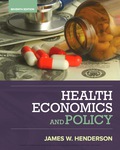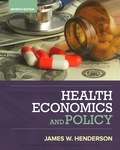
To provide definitions to terms used regularly by third party payers and explain these terms affect the providers’ incentives, fees and overall utilization.
a)
Fee for service payment model.
Answer to Problem 1QAP
The fee for service payment model is a traditional payment method in medical care where the provider bills for each service provided.
Explanation of Solution
Within a fee for service payment model providers can pass reimburse all their costs, with no regard on how inefficient the production of services. This system can be described as a cost-plus pricing system.
There is no incentive for providers to search for more efficient methods of production in a cost-plus environment. Furthermore, patients have no incentive to search for providers who offer lower prices. In comparison, competitive markets reward providers for offering quality products at the lowest price. However, in cost-plus markets, providers are rewarded by offering more services at higher prices while passing on the additional costs to third-party payers.
Introduction:
Certain concepts that exist within health care involve certain variances in terms of providers’ incentives, fees and overall utilization.
b)
Assignment.
b)
Answer to Problem 1QAP
An assignment can be defined as a Medicare policy that provides physicians a guaranteed payment of 80 percent of the allowable fee. By accepting an assignment, physicians agree to accept the allowable fee as full payment and forgo the practice of balance billing.
Explanation of Solution
From the perspective of the physician, the problem of assignment centers on the relationship between the fee usually charged for the service provided and the Medicare allowable fee, which is often much lower. Physicians' issue with the Medicare allowable fee is that it is below their average cost of providing medical services. Even though providing care to the Medicare segment of the market may not cover fully allocated costs, each transaction is reimbursed at a rate that covers the physician’s
c)
Capitation.
c)
Answer to Problem 1QAP
Capitation can be defined as a payment method that provides a fixed, per capita payment to providers for a specified medical benefits package. Capitation requires the providers to treat a well-defined population for a fixed sum of money, paid in advance, without regard to the number or nature of the services provided to each person.
Explanation of Solution
Providing care for a fixed fee changes the nature of the physician-patient relationship. Capitation has reduced the incentive of providers to purchase services that are largely unnecessary and take advantage of uninformed consumers. However, there is a risk of omitting potentially beneficial care in the name of cost-saving. However, under capitation, all necessary care is provided for a well-defined group. Hence utilization of services is in control of the provider.
d)
Risk Sharing.
d)
Answer to Problem 1QAP
Risk sharing contracts involves in the spreading of financial risks of health care towards the providers.
Explanation of Solution
Risk-sharing discourages the over utilization of services, the use of expensive technology, brand-name prescription drugs, referrals to specialists, and inpatient hospital procedures. Many managed care plans contract with primary care physicians using either prepayment or capitation (lump-sum payments per enrollee determined in advance). Prepayment shifts the financial risk to the providers. Rather than making payments on a per-service basis, primary care physicians will receive a fixed payment determined in advance to provide all necessary primary and preventive care for a specific group of patients. Some managed care plans involve withholding a percentage of the authorized payment so that providers control utilization and cost. Primary care physicians serve as gatekeepers who are under strict budgets for hospital services, specialty referrals, and prescription drugs for patients they cover. Bonuses are provided to physicians who provide care within the predetermined budgets. Those who do not are penalized. They are penalized through either forfeiting part or all of their withholdings to the plan. This risk-sharing arrangement provides strong incentives for physicians to control utilization.
Want to see more full solutions like this?
Chapter 8 Solutions
EBK HEALTH ECONOMICS AND POLICY
- In a small open economy with a floating exchange rate, the supply of real money balances is fixed and a rise in government spending ______ Group of answer choices Raises the interest rate so that net exports must fall to maintain equilibrium in the goods market. Cannot change the interest rate so that net exports must fall to maintain equilibrium in the goods market. Cannot change the interest rate so income must rise to maintain equilibrium in the money market Raises the interest rate, so that income must rise to maintain equilibrium in the money market.arrow_forwardSuppose a country with a fixed exchange rate decides to implement a devaluation of its currency and commits to maintaining the new fixed parity. This implies (A) ______________ in the demand for its goods and a monetary (B) _______________. Group of answer choices (A) expansion ; (B) contraction (A) contraction ; (B) expansion (A) expansion ; (B) expansion (A) contraction ; (B) contractionarrow_forwardAssume a small open country under fixed exchanges rate and full capital mobility. Prices are fixed in the short run and equilibrium is given initially at point A. An exogenous increase in public spending shifts the IS curve to IS'. Which of the following statements is true? Group of answer choices A new equilibrium is reached at point B. The TR curve will shift down until it passes through point B. A new equilibrium is reached at point C. Point B can only be reached in the absence of capital mobility.arrow_forward
- A decrease in money demand causes the real interest rate to _____ and output to _____ in the short run, before prices adjust to restore equilibrium. Group of answer choices rise; rise fall; fall fall; rise rise; fallarrow_forwardIf a country's policy makers were to continously use expansionary monetary policy in an attempt to hold unemployment below the natural rate , the long urn result would be? Group of answer choices a decrease in the unemployment rate an increase in the level of output All of these an increase in the rate of inflationarrow_forwardA shift in the Aggregate Supply curve to the right will result in a move to a point that is southwest of where the economy is currently at. Group of answer choices True Falsearrow_forward
- An oil shock can cause stagflation, a period of higher inflation and higher unemployment. When this happens, the economy moves to a point to the northeast of where it currently is. After the economy has moved to the northeast, the Federal Reserve can reduce that inflation without having to worry about causing more unemployment. Group of answer choices True Falsearrow_forwardThe long-run Phillips Curve is vertical which indicates Group of answer choices that in the long-run, there is no tradeoff between inflation and unemployment. that in the long-run, there is no tradeoff between inflation and the price level. None of these that in the long-run, the economy returns to a 4 percent level of inflation.arrow_forwardSuppose the exchange rate between the British pound and the U.S. dollar is £1 = $2.00. The U.S. government implementsU.S. government implements a contractionary fiscal policya contractionary fiscal policy. Illustrate the impact of this change in the market for pounds. 1.) Using the line drawing tool, draw and label a new demand line. 2.) Using the line drawing tool, draw and label a new supply line. Note: Carefully follow the instructions above and only draw the required objects.arrow_forward
- Just Part D please, this is for environmental economicsarrow_forward3. Consider a single firm that manufactures chemicals and generates pollution through its emissions E. Researchers have estimated the MDF and MAC curves for the emissions to be the following: MDF = 4E and MAC = 125 – E Policymakers have decided to implement an emissions tax to control pollution. They are aware that a constant per-unit tax of $100 is an efficient policy. Yet they are also aware that this policy is not politically feasible because of the large tax burden it places on the firm. As a result, policymakers propose a two- part tax: a per unit tax of $75 for the first 15 units of emissions an increase in the per unit tax to $100 for all further units of emissions With an emissions tax, what is the general condition that determines how much pollution the regulated party will emit? What is the efficient level of emissions given the above MDF and MAC curves? What are the firm's total tax payments under the constant $100 per-unit tax? What is the firm's total cost of compliance…arrow_forward2. Answer the following questions as they relate to a fishery: Why is the maximum sustainable yield not necessarily the optimal sustainable yield? Does the same intuition apply to Nathaniel's decision of when to cut his trees? What condition will hold at the equilibrium level of fishing in an open-access fishery? Use a graph to explain your answer, and show the level of fishing effort. Would this same condition hold if there was only one boat in the fishery? If not, what condition will hold, and why is it different? Use the same graph to show the single boat's level of effort. Suppose you are given authority to solve the open-access problem in the fishery. What is the key problem that you must address with your policy?arrow_forward

 Microeconomics: Private and Public Choice (MindTa...EconomicsISBN:9781305506893Author:James D. Gwartney, Richard L. Stroup, Russell S. Sobel, David A. MacphersonPublisher:Cengage Learning
Microeconomics: Private and Public Choice (MindTa...EconomicsISBN:9781305506893Author:James D. Gwartney, Richard L. Stroup, Russell S. Sobel, David A. MacphersonPublisher:Cengage Learning Economics: Private and Public Choice (MindTap Cou...EconomicsISBN:9781305506725Author:James D. Gwartney, Richard L. Stroup, Russell S. Sobel, David A. MacphersonPublisher:Cengage Learning
Economics: Private and Public Choice (MindTap Cou...EconomicsISBN:9781305506725Author:James D. Gwartney, Richard L. Stroup, Russell S. Sobel, David A. MacphersonPublisher:Cengage Learning
 Managerial Economics: A Problem Solving ApproachEconomicsISBN:9781337106665Author:Luke M. Froeb, Brian T. McCann, Michael R. Ward, Mike ShorPublisher:Cengage Learning
Managerial Economics: A Problem Solving ApproachEconomicsISBN:9781337106665Author:Luke M. Froeb, Brian T. McCann, Michael R. Ward, Mike ShorPublisher:Cengage Learning Exploring EconomicsEconomicsISBN:9781544336329Author:Robert L. SextonPublisher:SAGE Publications, Inc
Exploring EconomicsEconomicsISBN:9781544336329Author:Robert L. SextonPublisher:SAGE Publications, Inc





